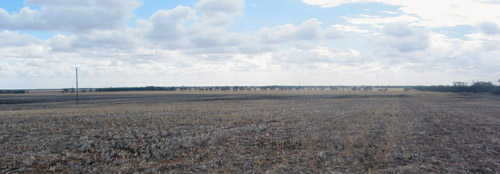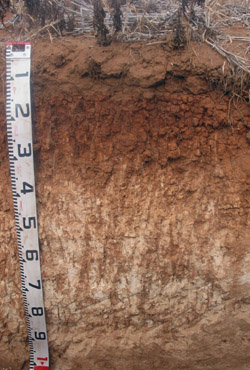TOPCROP1
Location: Brim
Australian Soil Classification: Hypercalcic, Subnatric, Red SODOSOL
General Landscape Description: Slight rise on undulating plain.
Site Description: Cropping Paddock, beans 2002, barley 2001.
Geology: Quaternary deposits (Woorinen Formation).

| TOPCROP1 Landscape |
Soil Profile Morphology:
Surface Soil
| Ap | 0-12 cm | Dark brown (7.5YR3/4); sandy clay loam; weak structure; very weak to weak consistence (dry), becoming firm at base of horizon; slight hardpan at base of horizon (9-12 cm depth); non-calcareous; pH 7.1; sharp change to: |  TOPCROP1 Profile |
| Subsoil | |||
| B21 | 12-25 cm | Dark red (2.5YR4/6 & 2.5YR4/8); medium heavy clay; strong coarse blocky, parting to moderate medium blocky structure; prismatic structure at base of horizon; strong consistence dry; non-calcareous; pH 8.8; clear change to: | |
| B22 | 25-40 cm | Yellowish red (5YR5/6); light medium clay; moderate coarse prismatic, parting to strong coarse blocky structure; very firm to strong consistence dry; few (5%) soft calcareous segregations; highly calcareous; pH 9.3; gradual change to: | |
| B23k | 40-90 cm | Yellowish red (5YR5/8); light medium clay; moderate coarse polyhedral, parting to medium polyhedral structure; strong consistence dry; very many (50%) soft calcareous segregations; very highly calcareous; pH 9.7: | |
| B24k | 90+ cm | Yellowish red (5YR5/8); light clay; weakly structured; strong consistence dry; very many (50%) soft calcareous segregations; pH 9.6. | |
Key Profile Features:
- Strong texture contrast between surface (A) horizons and subsoil (B21) horizon.
- Large amounts of calcium carbonate in deeper subsoil (from 40 cm depth).
Soil Profile Characteristics:
pH | Salinity Rating | |||
Surface (A1 horizon) | Slightly Alkaline | Low | Non-Sodic | None1 |
Subsoil (B21 horizon) | Strongly Alkaline | Medium | Sodic | None2 |
Deeper Subsoil (at 90+ cm) | Extremely Alkaline | Very High | Strongly Sodic | None3 |

| The surface is slightly alkaline. The subsoil is strongly alkaline becoming extremely alkaline with depth. | The surface has a low salinity rating. The upper subsoil has a medium salinity rating becoming very high with depth. | The surface is non-sodic. The upper subsoil is sodic becoming strongly sodic with depth. | Boron levels increase with depth. | Clay content increases markedly at the surface/ subsoil horizon boundary. |
Chemical and Physical Analysis:
Horizon | Horizon Depth (cm) | pH (water) | pH (CaCl2) | EC dS/m | NaCl % | Organic Carbon % | Nitrogen % | Boron mg/kg | Exchangeable Cations | Field Capacity pF2.5 | Wilting Point pF4.2 | Coarse Sand (0.2-2.0mm) | Fine Sand (0.02-0.2mm) | Silt (0.002-0.02mm) | Clay (<0.002mm) | |||
Ca | Mg | K | Na | |||||||||||||||
Meq/100g | ||||||||||||||||||
Ap | 0-12 | 7.1 | 6.6 | 0.14 | 0.95 | 0.07 | 1.1 | 7.0 | 2.1 | 1.1 | 0.28 | 12.3 | 6.0 | 38.2 | 36.0 | 6.0 | 14.0 | |
B21 | 12-25 | 8.8 | 8.1 | 0.39 | <0.01 | 3.9 | 12 | 11 | 1.2 | 3.2 | 38.5 | 20.6 | 24.9 | 24.1 | 10.5 | 38.5 | ||
B22 | 25-40 | 9.3 | 8.5 | 0.47 | 0.02 | 8.6 | 7.6 | 9.7 | 0.9 | 3.9 | 35.2 | 19.2 | 26.3 | 24.1 | 13.5 | 24.5 | ||
B2k3 | 40-90 | 9.7 | 8.6 | 0.53 | 0.04 | 13 | 3.9 | 8.9 | 1.0 | 5.1 | 34.7 | 18.4 | 29.2 | 21.6 | 4.0 | 28.0 | ||
B24k | 90+ | 9.6 | 8.7 | 1.0 | 0.13 | 21 | 2.8 | 8.4 | 1.1 | 6.3 | ||||||||
Management Considerations:
Surface (A) Horizons
- In general, management strategies for all soils should aim to increase organic matter levels in the surface soil; minimise the degradation of soil aggregates and porosity; promote the development of stable biopores; improve the calcium status of the ion exchange complex (particularly when sodium is a significant part), and break up any hardpans. Less frequent tillage; using less aggressive implements, and working the soil at optimum moisture conditions can all assist in maintaining soil aggregation and porosity as well as reducing the breakdown of organic matter.
- The surface soil is non-sodic but disperses slightly-moderately after remoulding. This indicates that some structural degradation (e.g. surface sealing, increased cloddiness) may occur if the soil is cultivated or overstocked in a moist to wet condition. Also, raindrop action on bare soil may also promote dispersion and result in surface sealing or surface crust formation. Surface cover should be maintained to protect against raindrop damage. The use of gypsum may also assist in ameliorating the surface soil.
- The coarsely structured subsoil is sodic which indicates that root and water movement will be restricted in the subsoil.
- The subsoil is strongly to extremely alkaline. This indicates that phosphorus and some trace elements such as iron, manganese, zinc and copper may be poorly available to plants and deficiencies may occur. Deficiencies can be determined by plant tissue analysis.
- The levels of soluble salts become high at 90 cm depth. This may restrict the growth of deeper rooted salt-sensitive species.
- Boron toxicity can also occur in strongly alkaline soils. Levels of boron measured in the deeper subsoil at this pit site may affect boron sensitive species. Boron levels increase in the very strongly alkaline subsoil (from 40 cm depth) - to levels which may affect the growth of boron sensitive species (including cereals, pulses, pasture legumes). [concentrations as low as 10 ppm, for example, can reduce lentil yield. Limited data estimates that the threshold for level of soluble boron for cereals is 15 mg/kg (Cartwright et al, 1984). Other work at VIDA indicates that without the presence of significant levels of soluble salts, that Boron tolerance can be comparatively high, with little reduction in wheat yield at levels of up to 45 ppm (Quinlan, 2001).]
Profile Described By: Mark Imhof and Brooke Thompson (December 2002)
References:
Cartwright, B., Zarcinas, B.A, and Mayfield, A.H. (1984). Toxic concentrations of boron in a red-brown earth at Gladstone, South Australia. Australian Journal of Soil Research. 22. 261-72.
Hobson, K. (2001). Boron Tolerant Lentils. In On The Pulse pamphlet. NRE. 2001.
Quinlan, J. (2001). Sorting out the Boron Problem. Wimmera Farming & Landcare Newsletter. 19-20.
Rengasamy, P. and Churchman, G.J. (1999). Cation Exchange Capacity, Exchangeable Cations and Sodicity. In: Soil Analysis – An Interpretation Manual. (eds. Peverill, K.I et al). CSIRO Publishing.


